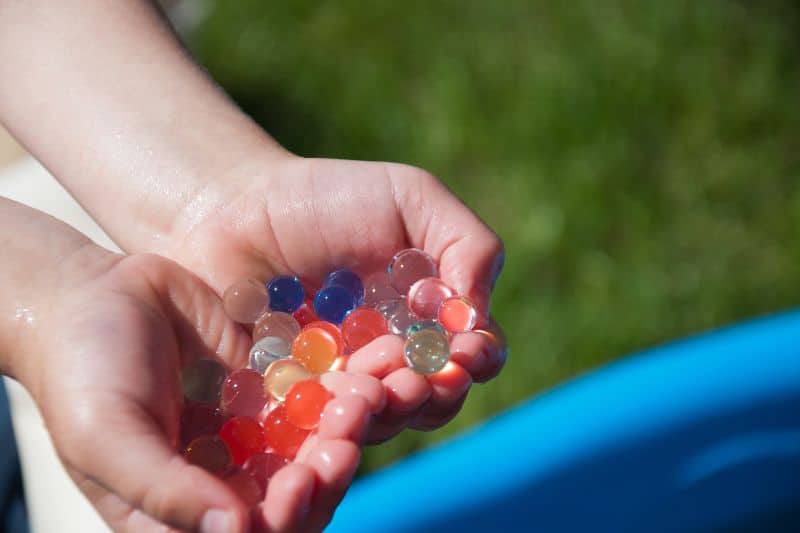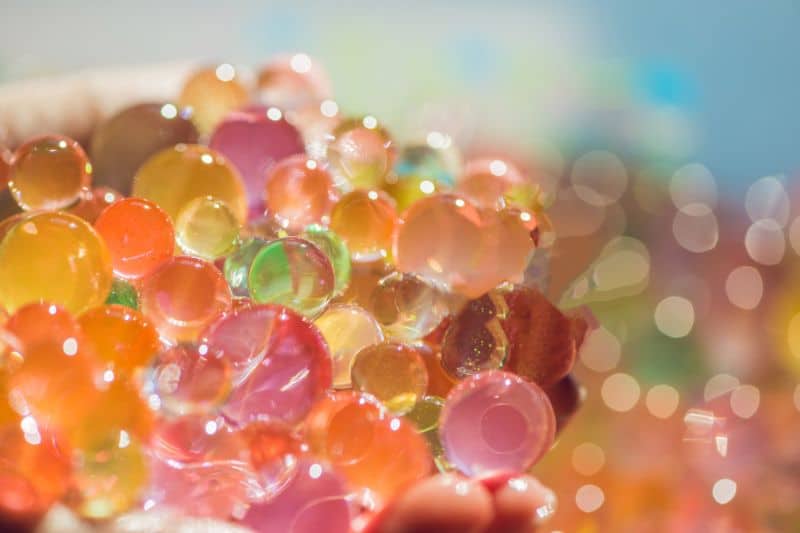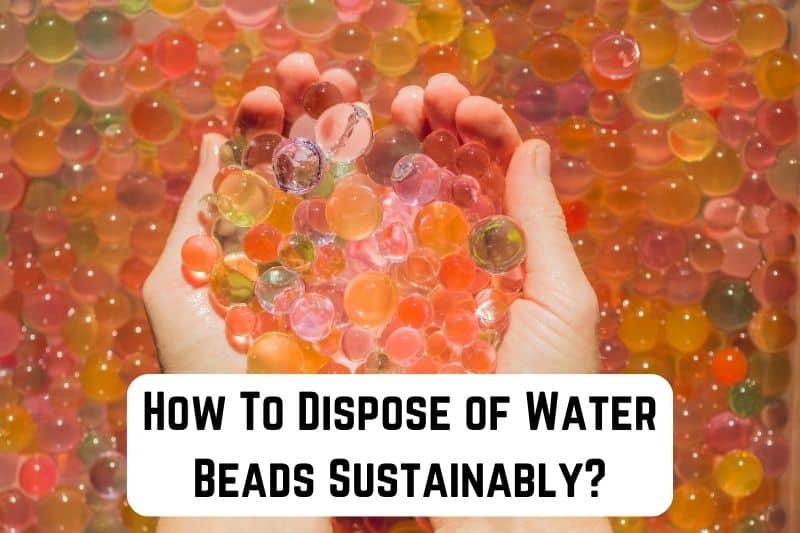Most likely, you’ve already encountered water beads. These are those tiny water balls with vibrant colors that you can use to make lovely arrangements in fish tanks, vases, and other containers. They’re frequently utilized in centerpieces and floral arrangements as well.
Water beads are visually stunning, but cleaning them up after use can be a hassle. For this reason, many people throw them in the trash, although doing so can be hazardous and bad for the environment. Let’s look into the safe and effective disposal of water beads.
Read: Are Orbeez (Water Beads) Biodegradable?
Why Dispose of Water Beads?
Get rid of water beads (Orbeez) to protect the environment. They can cause choking hazards for dogs and children if consumed. Additionally, they can harm ecosystems if flushed through drains or streams, clogging pipes.
Before throwing them in the garbage, let them dry in an airtight container for safe disposal. Recycle materials responsibly at all times to reduce environmental and public health hazards. Polymers that absorb water are called water beads. Originally, florists employed them in their floral creations.
Their capacity to retain water allowed them to maintain the hydration of plants without sacrificing their aesthetic appeal. Teachers realized later how they could be used for certain sensory and instructional purposes. Water beads don’t cause harm. Nevertheless, little children may choke on them, and are not meant to be consumed.
Unopened water beads have a far longer shelf life than ones that have been handled since there is a greater chance of mold growing. Before using the same water beads twice, thoroughly check for black spots. You must throw out the water beads immediately if you notice any black patches, which indicate the presence of mold.
Water droplets decompose naturally. After using them up, you can either throw them outside or incorporate them into your potted plants—this is an excellent method of rehydrating your garden! Although water beads are healthy for the environment, you can throw them in your trash can if you’re worried that animals or pets might try to eat them.
Various Ways To Dispose of Water Beads
Your water beads have a limited lifespan, so even though you can reuse them multiple times, you will eventually have to dispose of them. People are frequently worried about the possible environmental effects of water beads and how to dispose of them. We will go over the best waste disposal practices below.
Dry Them in the Sun
You may remove water beads by letting them dry in the sun. This can be achieved by keeping them in an open jar in a dry, warm place. They can be disposed of in the garbage after they have dried out.
Bury Them
Since water beads decompose naturally, they will eventually become soil. Just be sure to bury them far enough below the surface so that little children or pets cannot find them.
Shrink Them
Always consider if something can be used again around the house before disposing of it. So, lots of the things that we throw away are recyclable. It may even save you money! It minimizes your carbon impact and the quantity of waste you produce!
Look around the house to see whether you’ve finished utilizing your water beads as ornamental elements or if your kids have grown tired of them. You may be able to find them a new home. It’s really simple to shrink and preserve them for later use, even if you choose not to. You are always curious when your kids will want to pick up the water bead game again.
Take Them to the Garden
Why not utilize the water beads in your garden if you are positive you won’t need them any longer? You read correctly. Water beads are a stylish method to irrigate your plants. Originally, water beads were exclusively intended for use in gardening.
People only utilized them as decorations inside much later, and ultimately, little children managed to get their hands on them. Adding your water beads to the fertile soil in your vegetable patch, backyard, or on a few potted plants is a very eco-friendly and fruitful use for them.
You can add the ingredients exactly as they are or break them up with your hands to provide more surface area. Let the beads become an element of nature by blending them with the soil. The beads’ biodegradable composition means they will gradually break down in the soil. They will likely continue to leak water for as long as twenty-four months before disintegrating.

Do Water Beads Decompose?
Water beads are non-biodegradable polymer materials, sometimes called hydrogel beads or water-absorbing gel beads. They don’t break down in the environment naturally. Although water beads do not break down independently, exposure to air can cause them to dry out and shrink over time.
A water bead’s lifespan is determined by how it is utilized. The beads only last briefly and require very little air exposure if used in light-up devices. In contrast, the water beads should survive a year or two if you plan to use them as decorations.
When blended with soil, water beads last the longest. They can easily labor at your plants’ water reservoir for a good seven to nine years. This is because, deep below, they are the least exposed to light and air. A dry, dark space is ideal for water beads to maintain their internal polymer production.
Since microplastics may quickly infiltrate the food chain and harm wildlife, they are becoming an increasingly serious environmental concern. Although water beads don’t necessarily threaten the environment, their release can lead to issues.
When water beads break down, the absorbed water is released, which might reduce the amount of water in the vicinity. Furthermore, the polymer used to create water beads has the potential to release toxic compounds into the surrounding air.
The degradation of water beads usually takes several months. However, several variables, such as temperature and sunshine exposure, affect how quickly they deteriorate. Warmer and brighter environments generally cause water beads to break down more quickly.
Can Water Beads Go in the Garbage Disposal?
Putting water beads into a waste disposal is not advised. The purpose of garbage disposals is to dispose of food waste; adding non-food objects, such as water beads, could harm the disposal device. Before disposing of water beads in the trash, allowing them to dehydrate in an airtight container or bag is best.
Water bead disposal like this isn’t recommended because it takes up unnecessary space in overflowing landfills. Water beads also cannot be disposed of in the recycling containers with your other biodegradable waste.
You should watch out for a few things if you decide to use this final resort. Place them in a biodegradable bag or container whenever possible before throwing them in the garbage. Water beads readily spill out because they are tiny and slick. If this occurred, individuals might trip and fall or even get sucked up by little children or dogs.

What Breaks Down Water Beads?
Extended exposure to air dehydrates water beads, making them return to their initial size. Extreme heat or chemical reactions can also degrade water beads. One way to dispose of them is to dehydrate them in an airtight container before throwing them in the ordinary trash.
Water beads may become dehydrated and shrink over time if exposed to air or kept in a dry environment, even if they do not break down through decomposition. The beads progressively lose the moisture they have collected throughout this process, shrinking back to their original size.
There is no disintegration in the sense of breaking down into natural elements due to dehydration. Water beads’ superabsorbent polymer is typically not biodegradable. These polymers are designed to hold water inside their structure for extended periods without disintegrating into smaller, less harmful parts for the environment.
FAQ’s
Can water beads kill you?
Yes! Intestinal harm that could be fatal can result from swallowing water beads. A youngster eating a water bead has resulted in at least one death. In one instance, a neighbor gave a 6-month-old baby a single superabsorbent polymer bead, which he swallowed and experienced a bowel blockage.
How can I store water beads?
Airtight jars with lids or plastic bags are ideal for storing full-sized water beads. After giving them a quick rinse, keep them dry and out of children’s and dogs’ reach. When you’re ready to play again, all you need to do is add water to rehydrate the water beads.
How do water beads work?
Full-sized water beads are stored best in plastic bags, sealed jars with covers, or snap-top containers. Once they’ve had a short rinse, keep them somewhere dry yet safely out of the reach of kids and pets. All you have to do to get the water beads back to playing temperature is add water.
Can I pour water beads down the drain?
No, you shouldn’t ever dump water beads down the toilet. These are tiny beads, so they should break and dissolve. Sadly, things don’t operate that way. They can be physically capable through the conduit but can also lead to plumbing problems and obstructions. The problem is that they swell when they come into contact with water.
Conclusion
You are now fully aware of water bead’s environmental effects. They have a strong bond with the environment as well as with people. Playing with them is now safe for you and your children. But remember that this does not indicate that you should handle water beads carelessly.
You now understand everything there is to know regarding water beads and their removal. Just be careful not to pour them down the drain or flush them down the toilet.






